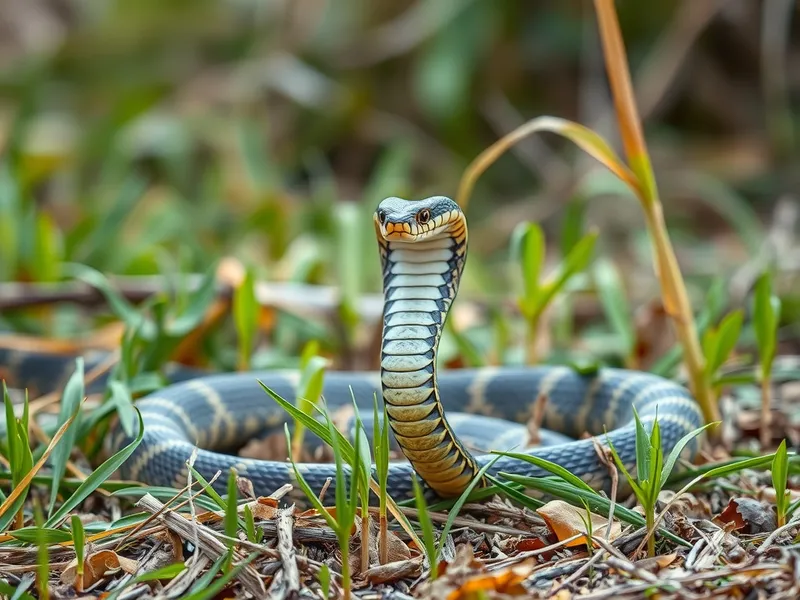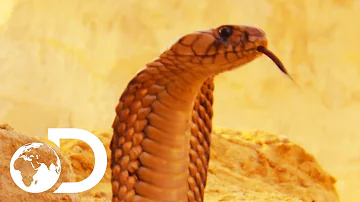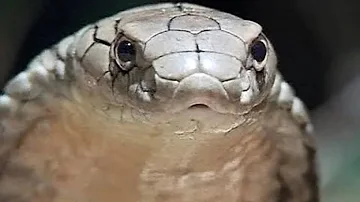
Egyptian Cobra
Naja haje

Meet the Egyptian Cobra
The Egyptian Cobra is a large, highly venomous snake native to North Africa and parts of the Middle East. Renowned for its iconic hood, this snake can reach lengths of up to 2.4 meters and typically displays a uniform brown, copper, or gray coloration. It is primarily nocturnal, hunting for prey such as rodents, birds, and other small vertebrates, and uses its potent neurotoxic venom to immobilize and kill. The Egyptian Cobra has played a prominent role in ancient Egyptian mythology and iconography, often associated with royalty and divine protection.
Classification
Reptile
Habitat
Grasslands, savannas, scrubland, agricultural fields, and near human settlements
Diet
Carnivore
Lifespan
15-20 years
Conservation
Least Concern
Weight
1.5-3 kg
📖Fascinating Facts
Iconic Hood
When threatened, the Egyptian Cobra spreads its ribs to create a broad, flattened hood as a warning display.
Cultural Symbol
The Egyptian Cobra was revered in ancient Egypt and often depicted on royal headdresses as the 'uraeus,' symbolizing sovereignty and protection.
Potent Venom
Its venom contains powerful neurotoxins that can cause respiratory failure in prey or humans if left untreated.
📋Detailed Description
The Egyptian cobra (Naja haje) is a robust, medium-to-large elapid snake, typically measuring between 1.4 and 2 meters in length, though exceptional individuals can reach up to 2.59 meters. Its body is cylindrical and muscular, with a broad, slightly flattened head distinct from the neck, and large, rounded eyes with circular pupils. The species is renowned for its ability to expand its cervical ribs, forming a characteristic hood when threatened. Coloration varies widely across its range, from uniform shades of brown, copper, or gray to specimens with darker bands or lighter ventral surfaces; juveniles often display more pronounced patterning. The scales are smooth and glossy, aiding in rapid movement through diverse habitats. Egyptian cobras are primarily terrestrial but are capable swimmers and occasionally climb low vegetation. They are predominantly nocturnal, seeking shelter in abandoned burrows, termite mounds, or crevices during the day. The species possesses large venom glands and delivers a potent neurotoxic venom through fixed front fangs, which it uses both for subduing prey and defense. Egyptian cobras are solitary outside of the breeding season and exhibit a secretive, elusive nature, avoiding open confrontation with humans when possible.
💡 Did you know?
Legend has it that Cleopatra used the venom of the Egyptian Cobra to end her own life.
🔬Research & Sources
Wikipedia Summary
The Egyptian cobra is one of the most venomous species of snakes in North Africa. It averages roughly 1.4 metres (4.6 ft) in length; the longest specimen recorded so far measured 2.59 metres (8.5 ft).
Last Modified: 5/26/2025
🎭Behavior & Social Structure
Egyptian cobras are largely solitary and display crepuscular to nocturnal activity patterns, emerging at dusk to hunt. Their diet consists mainly of small mammals such as rodents, birds, amphibians, lizards, and occasionally other snakes. They use a combination of chemical cues (via the Jacobson's organ) and visual hunting strategies, relying on stealth to approach prey before delivering a rapid strike. The venom acts quickly, causing paralysis and respiratory failure in prey. After envenomation, the snake often releases the prey and waits for it to succumb before consumption. Egyptian cobras are generally non-aggressive but will display defensive behaviors—such as hood expansion, hissing, and mock strikes—if threatened. They are known to inhabit areas near human settlements, where they help control rodent populations. During the day, they seek refuge in cool, concealed locations to avoid the harsh desert sun. Social interactions are limited, with encounters between adults typically resulting in avoidance or, during the breeding season, ritualized combat between males.
👶Reproduction & Life Cycle
Naja haje is oviparous, with breeding typically occurring in the spring or early summer, depending on local climatic conditions. Males engage in combat for access to receptive females, intertwining and attempting to pin each other. After mating, females lay clutches of 8 to 33 eggs in concealed, humid locations such as abandoned burrows or under debris. The incubation period ranges from 50 to 80 days, influenced by ambient temperature and humidity. Females do not exhibit parental care after egg-laying; hatchlings are independent from birth and measure approximately 20–25 cm in length. Juveniles possess fully functional venom glands and are capable of hunting and defending themselves immediately. Sexual maturity is typically reached at 3 to 4 years of age.
🛡️Adaptations & Survival
The Egyptian cobra exhibits several adaptations for survival in arid and semi-arid environments. Its smooth, glossy scales reduce water loss and facilitate rapid movement across sand and rocky substrates. The ability to expand its hood serves as an effective visual deterrent against predators. Its neurotoxic venom is highly specialized for rapid immobilization of warm-blooded prey, and the snake's acute chemosensory abilities allow it to locate prey even in low-light conditions. Behavioral adaptations include nocturnality to avoid daytime heat and a preference for sheltering in cool, humid microhabitats. The species' tolerance for disturbed habitats and proximity to human settlements has enabled it to persist despite environmental changes.
📚Research Sources
🎨Cultural Significance
The Egyptian cobra holds profound significance in ancient Egyptian culture, where it was revered as the 'uraeus'—the stylized, upright form of the cobra depicted on pharaonic crowns as a symbol of sovereignty, divine authority, and protection. Associated with the goddess Wadjet, the cobra was believed to ward off evil and protect the king. The species appears in numerous myths, religious texts, and funerary art. In modern times, the Egyptian cobra continues to feature in folklore, traditional medicine, and as a symbol of Egypt's natural heritage. Its image is sometimes used in jewelry, art, and emblems.
🔬Recent Research & Discoveries
Recent molecular studies have clarified the taxonomy of Naja haje, distinguishing it from closely related African and Middle Eastern cobras. Research into venom composition has revealed significant geographic variation, with implications for antivenom development and medical treatment of envenomation. Ecological studies have highlighted the species' role in regulating rodent populations, particularly in agricultural settings. Ongoing research focuses on the effects of habitat fragmentation, urban encroachment, and climate change on population genetics and distribution. The Egyptian cobra is also a subject of interest in studies of snake behavior, neurotoxin evolution, and human-wildlife conflict mitigation.
🎥Wildlife Videos

The Egyptian Cobra: Deadliest Snake in Egypt | Wildlife Documentary
In this wildlife documentary, we explore the Egyptian cobra (Naja haje), one of the deadliest venomous snakes in the world.
TheWildlifeScience

The Most Deadly Snake Of The Egyptian Desert | Wildest Middle East
See some of the many reptile which live in the Egyptian desert, including the Egyptian cobra, the most deadly snake in the region, ...
Discovery UK

The Deadly King Cobra!
It seems unfairly menacing that a snake that can literally "stand up" and look a full-grown person in the eye would also be among ...
Amazing Documentaries

Spits & Stings | Animal Armory | Episode 5 | Free Documentary Nature
Animal Armory - Episode 5: Spits & Stings | Animal Documentary Watch 'Animal Armory - Episode 6' here: ...
Free Documentary - Nature

Deadly Egyptian Cobra: Facts, Venom, and Stunning Close-Up!"
Discover the fascinating world of the Egyptian Cobra, one of the most iconic and dangerous snakes on the planet. In this video, we ...
infinite discovery

Egyptian Cobra in Selenkay Conservancy
The Egyptian cobra is a venomous snake species found in Africa and the Middle East. It is one of the largest cobra species, with ...
Gamewatchers Safaris and Porini Camps
🌍Habitat Information
The Egyptian Cobra typically inhabits Grasslands, savannas, scrubland, agricultural fields, and near human settlements environments. Egyptian Cobras have adapted to their environments with specialized features and behaviors.
Primary Habitat:
Grasslands, savannas, scrubland, agricultural fields, and near human settlements
More detailed habitat information will be available soon.
🛡️Conservation Status
The Egyptian Cobra is currently classified as Least Concern. Conservation efforts are crucial for preserving this species for future generations.
Common Threats:
- 🏠Habitat loss and fragmentation
- 🌡️Climate change impacts
- 🎯Hunting and poaching
- 🏭Human-wildlife conflict
⚠️Threats & Conservation Challenges
Currently assessed as 'Least Concern' by the IUCN, the Egyptian cobra maintains stable populations across much of its range. However, localized threats include habitat loss due to agricultural expansion, urbanization, and persecution by humans who fear snakebite. The species is sometimes collected for the exotic pet trade and traditional medicine, though not at levels currently threatening its survival. Road mortality and intentional killing are additional pressures in areas of high human density. Despite these challenges, the Egyptian cobra's adaptability to varied habitats and its role in controlling pest populations contribute to its resilience.
🔬Scientific Classification
Scientific Name
Naja haje
Classification Hierarchy
🔍 About Taxonomic Classification
Taxonomic classification is a hierarchical system used by scientists to classify and organize living organisms based on shared characteristics and evolutionary relationships.
The system moves from broad categories (Kingdom) to increasingly specific ones, with each animal's scientific name typically consisting of its Genus and species.
📝Community Notes
Share your observations and insights about the Egyptian Cobra with our community of wildlife enthusiasts.
Join Our Community
Sign in to share your observations and connect with fellow wildlife enthusiasts.
Sign In to ContributeNo community notes yet
Be the first to share your observations about the Egyptian Cobra!
Explore Egyptian Cobra
Select a tab above to learn more about this amazing animal.
📸Photo Gallery
No photos available for this animal yet.
🌟Discover More Wildlife
Continue your journey of discovery with more fascinating animals from our database
